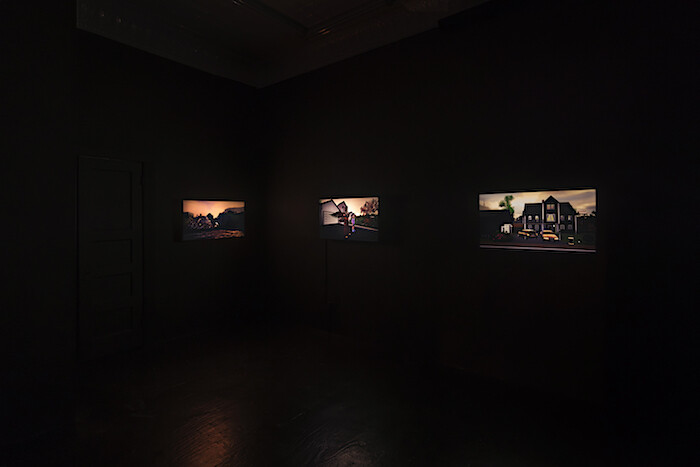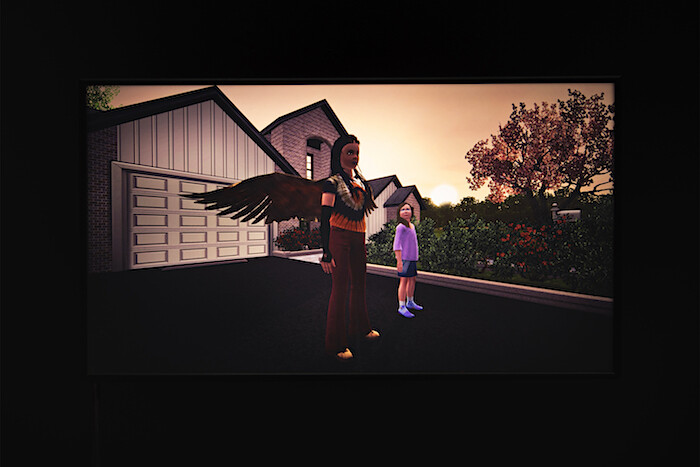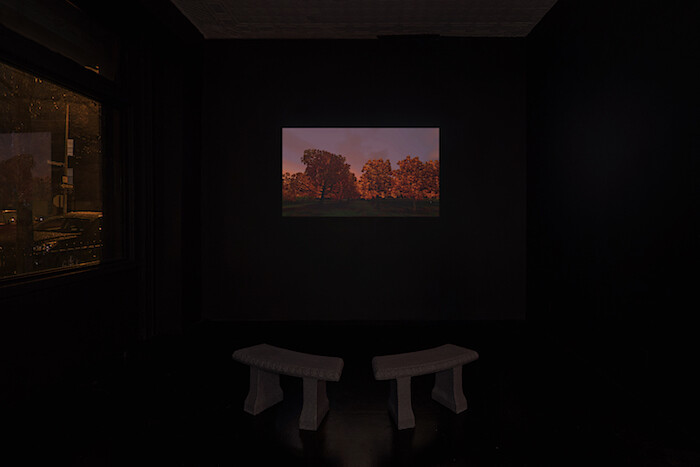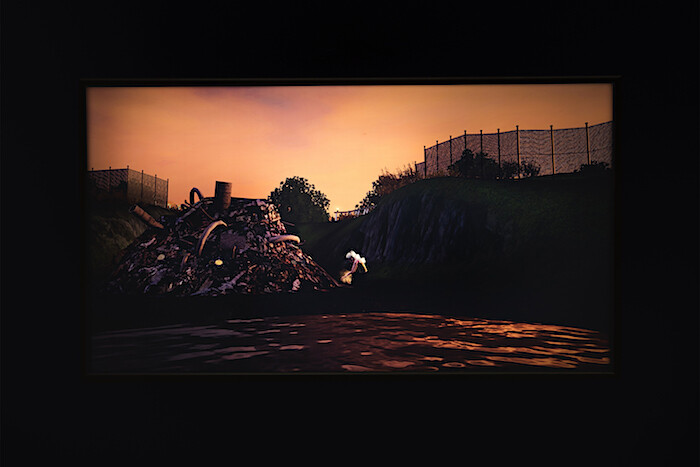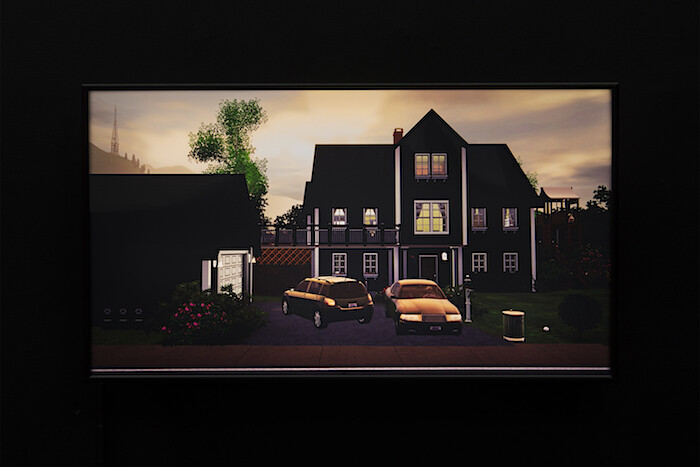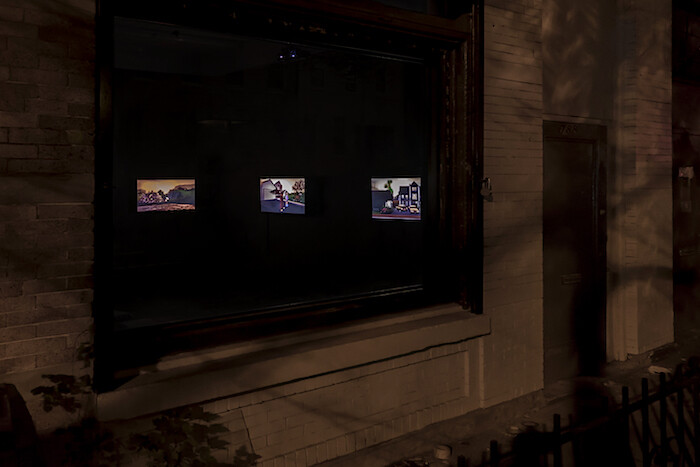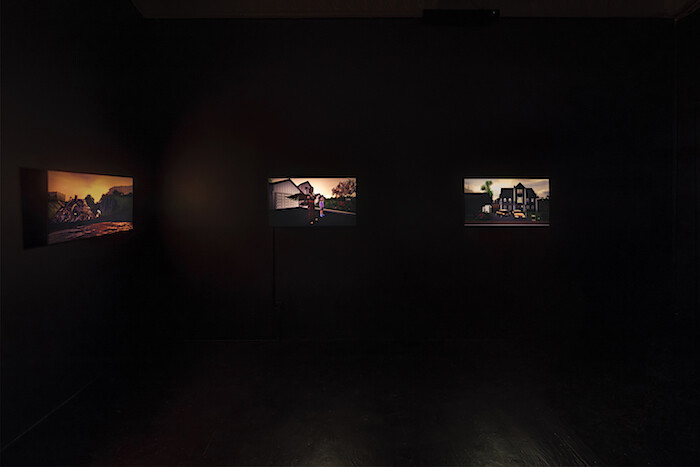A source of artistic fascination since the nineteenth century, when it became the subject of the Hudson River School of landscape painters, the grandeur of Upstate New York’s Hudson Valley also figures in Jacky Connolly’s first solo exhibition, at Kimberly-Klark in Queens, New York. The exhibition’s centerpiece is a video projected against the wall of the darkened gallery—for the duration of the show, the gallery is only open during the evening. Entitled Hudson Valley Ruins (2016), the video, as with all of the artist’s, has been constructed entirely within the computer game The Sims 3 (2009). Named after a website that chronicles the region’s abandoned architectural landmarks, it is set in a virtualized Hudson Valley with an ambience that might best be described as rural-suburban Halloween macabre circa 2004. Hudson Valley Ruins’s opening sequence clearly situates its aesthetic coordinates—cartoonishly gothic red lettering displays the title over a shot, at dawn, of rolling hills, fall foliage and, in the foreground, a weather vane on the roof of a lone house. The wind whistles threateningly, a motif that persists throughout the video’s half hour. Then, it begins to rain.
Like The Sims, Hudson Valley Ruins contains no dialogue, but is accompanied by in-game sounds, such as the eerie, unrelenting wind and the incidental sounds made by its characters—the clicking of fingers on a video game console or the noise of a child on a rusty swing set, for example. Featuring an ensemble cast organized around two protagonists, a young girl and an adolescent one go about their days in a contemporary, suburbanized Hudson Valley. Much of the detail is mundane, such as eating, exercising, or going to school, but more sinister undercurrents can be picked out of the video’s disjointed narrative. Early on, the adolescent can be seen sitting at a desktop computer chatting to a boy online and banging her hands on the desk in seeming frustration, while later she pulls reluctantly away from the same boy as he gropes her on the couch. They can then be seen having aggressive sex, followed by a trip for the adolescent and her stern-looking mother to a therapist with a prominently displayed safe sex poster. Broken homes are a common thread—the adolescent is raised by a single mother, while the younger girl is witness to her father’s extramarital affair. The titular ruins, as Connolly herself notes in an interview, refer to people rather than architecture: “Instead of ruined buildings, this film contains ruined people who seek refuge in imaginary/disappearing places.”1
And yet a sense of collapse, or of never having had a solid foundation to begin with, is deeply inscribed on the built architecture of the video’s setting. Surreal juxtapositions abound in Connolly’s elaborately detailed interiors, which could be read as taking the consumer object fixation of The Sims to subversive excess, and feature oddities such as inexplicable Chagall paintings in a suburban living room and a pretzel-shaped bench on a front porch. Nothing, however, feels like a massive leap from the already highly elastic principles of postmodern suburban design. (This free-for-all wresting of signifiers from any historical mooring is cannily alluded to in an installation feature of the exhibition—two benches fabricated in the sort of faux-Greco-Roman style that is a ubiquitous feature of suburban non-places provide the gallery seating for the video.)
A connection can be established here between the domestic settings that the characters inhabit, and are determined by, and the game through which they are rendered, in which one can escape from real life with a highly circumscribed simulation. Both are spaces of respite, where fantasies can be acted out, and both can become stifling and dull if one remains in them for too long. For an artist of the first generation “raised by the internet,” digital and domestic space have perhaps become one and the same thing—deeply tied to one’s sense of identity and personal narrative, and capable of evoking a similar sense of homeyness and belonging.
All of this situates Connolly’s work in the context of peers such as Bunny Rogers, Flannery Silva, and Maggie Lee, where signifiers of the domestic and of childhood (specifically girlhood) are redeployed as markers of personal identity and cultural affiliation. While the video’s setting matches Connolly’s biography almost exactly (she grew up in the lower Hudson Valley), its aesthetic concerns suggest a more performative exploration of identity enacted through highly specific sociocultural markers. Hudson Valley Ruins’s formal peculiarities create slippages between fantasy and reality that radically depersonalize its subjects, such that their personal trauma, malaise, and alienation aren’t expressive so much as they are built into the environment. In this world, whose characters have been rendered mute, the looming, overbearing presence of their surroundings—whether that be the howling wind or the hum of the refrigerator—speaks on their behalf.
On its surface a story of suburban angst, the video speaks to the sometimes debilitating intractability of place and past against the escape promised by virtual life and the avatar. On the two walls opposing the projected video are three light boxes, (Majella (Dirty Fill); When The Wind Blows (The Adoption); and Strange Weather (The Divorce) (all 2016), depicting scenes from the world of Hudson Valley Ruins. While an unnecessary corollary to the show’s cinematic centerpiece, in recalling the backlit promotional movie posters often found at theaters, they remind that nostalgia most often serves to transform personal narrative into commodity.
Emma Hazen, “Artist Profile: Jacky Connolly,” Rhizome, February 5, 2016, https://rhizome.org/editorial/2016/feb/05/artist-profile-jacky-connolly/.
